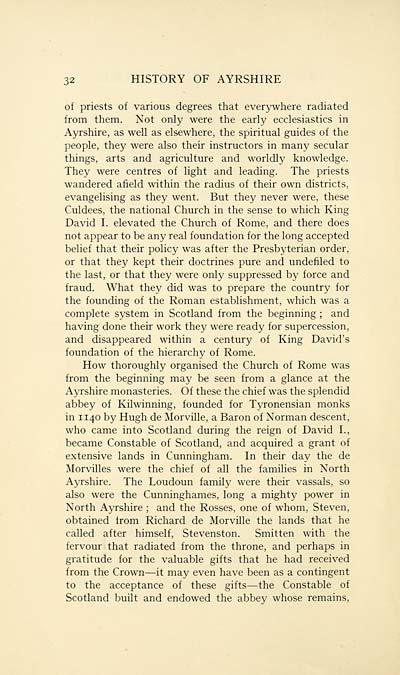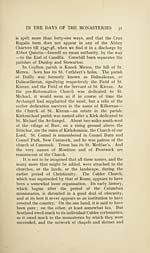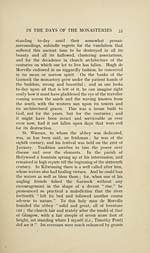Download files
Complete book:
Individual page:
Thumbnail gallery: Grid view | List view

32 HISTORY OF AYRSHIRE
of priests of various degrees that everywhere radiated
from them. Not only were the early ecclesiastics in
Ayrshire, as well as elsewhere, the spiritual guides of the
people, they were also their instructors in many secular
things, arts and agriculture and worldly knowledge.
They were centres of light and leading. The priests
wandered afield within the radius of their own districts,
evangelising as they went. But they never were, these
Culdees, the national Church in the sense to which King
David I. elevated the Church of Rome, and there does
not appear to be any real foundation for the long accepted
belief that their policy was after the Presbyterian order,
or that they kept their doctrines pure and undefiled to
the last, or that they were only suppressed by force and
fraud. What they did was to prepare the country for
the founding of the Roman establishment, which was a
complete system in Scotland from the beginning ; and
having done their work they were ready for supercession,
and disappeared within a century of King David's
foundation of the hierarchy of Rome.
How thoroughly organised the Church of Rome was
from the beginning may be seen from a glance at the
Ayrshire monasteries. Of these the chief was the splendid
abbey of Kilwinning, founded for Tyronensian monks
in 1140 by Hugh de Morville, a Baron of Norman descent,
who came into Scotland during the reign of David I.,
became Constable of Scotland, and acquired a grant of
extensive lands in Cunningham. In their day the de
Morvilles were the chief of all the families in North
Ayrshire. The Loudoun family were their vassals, so
also were the Cunninghames, long a mighty power in
North Ayrshire ; and the Rosses, one of whom, Steven,
obtained from Richard de Morville the lands that he
called after himself, Stevenston. Smitten with the
fervour that radiated from the throne, and perhaps in
gratitude for the valuable gifts that he had received
from the Crown — it may even have been as a contingent
to the acceptance of these gifts — the Constable of
Scotland built and endowed the abbey whose remains.
of priests of various degrees that everywhere radiated
from them. Not only were the early ecclesiastics in
Ayrshire, as well as elsewhere, the spiritual guides of the
people, they were also their instructors in many secular
things, arts and agriculture and worldly knowledge.
They were centres of light and leading. The priests
wandered afield within the radius of their own districts,
evangelising as they went. But they never were, these
Culdees, the national Church in the sense to which King
David I. elevated the Church of Rome, and there does
not appear to be any real foundation for the long accepted
belief that their policy was after the Presbyterian order,
or that they kept their doctrines pure and undefiled to
the last, or that they were only suppressed by force and
fraud. What they did was to prepare the country for
the founding of the Roman establishment, which was a
complete system in Scotland from the beginning ; and
having done their work they were ready for supercession,
and disappeared within a century of King David's
foundation of the hierarchy of Rome.
How thoroughly organised the Church of Rome was
from the beginning may be seen from a glance at the
Ayrshire monasteries. Of these the chief was the splendid
abbey of Kilwinning, founded for Tyronensian monks
in 1140 by Hugh de Morville, a Baron of Norman descent,
who came into Scotland during the reign of David I.,
became Constable of Scotland, and acquired a grant of
extensive lands in Cunningham. In their day the de
Morvilles were the chief of all the families in North
Ayrshire. The Loudoun family were their vassals, so
also were the Cunninghames, long a mighty power in
North Ayrshire ; and the Rosses, one of whom, Steven,
obtained from Richard de Morville the lands that he
called after himself, Stevenston. Smitten with the
fervour that radiated from the throne, and perhaps in
gratitude for the valuable gifts that he had received
from the Crown — it may even have been as a contingent
to the acceptance of these gifts — the Constable of
Scotland built and endowed the abbey whose remains.
Set display mode to:
![]() Universal Viewer |
Universal Viewer | ![]() Mirador |
Large image | Transcription
Mirador |
Large image | Transcription
Images and transcriptions on this page, including medium image downloads, may be used under the Creative Commons Attribution 4.0 International Licence unless otherwise stated. ![]()
| Histories of Scottish families > Ayrshire > Volume 1 > (42) Page 32 |
|---|
| Permanent URL | https://digital.nls.uk/95194790 |
|---|
| Attribution and copyright: |
|
|---|
| Description | A selection of almost 400 printed items relating to the history of Scottish families, mostly dating from the 19th and early 20th centuries. Includes memoirs, genealogies and clan histories, with a few produced by emigrant families. The earliest family history goes back to AD 916. |
|---|

